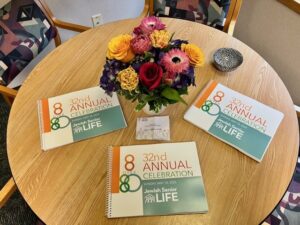MAY IS OLDER AMERICANS’ MONTH
By Jo Strausz Rosen
Recently JSL’s Executive Director of Strategic Initiatives, Barbra Giles, flew to Washington, D.C. as a member of LeadingAge, Michigan to speak with members of Congress and the Senate about issues and policies affecting older adults at JSL. She met with Rep. Rashida Tlaib and her aides, and with aides from the offices of Senator Gary Peters’, Debbie Stabenow, Elyssa Slotkin, Tim Walberg, and Rep. Dan Kildee. LeadingAge followed up with information affecting non-profits providing services to older adults. Here are some of their findings…
“In early 2021, LeadingAge embarked on a research initiative aimed at better understanding public views and perceptions of the aging services sector. Of course, many factors shape perceptions of the sector, so they explored everything from the media and political landscape to the opinions of leaders and influencers, to the views of the public. The results paint a complex picture of a sector that is not well understood but has the potential for meaningful public support. This report is a snapshot of findings from: a landscape analysis; two national public opinion surveys; a series of in-depth interviews with stakeholders from the field and adjacent sectors; a survey of LeadingAge members; and a set of focus groups composed of potential consumers and family members of aging services, current consumers, and family members, as well as current and prospective staff.”
“The landscape is grounded in a simple reality: we are all growing older. In fact, the aging population in the United States is growing exponentially. Americans from across this country are poised to live well into our eighth or ninth decade of life, and seven in ten will need long-term care and services—on top of the support we receive from our families and friends. At the same time, there is an emerging gap between the number of available caregivers and the number required to meet the needs of older adults. The caregiver support ratio in the United States is expected to decline between 2016 and 2060 from 31 to just 12 people of working age for every adult 85 and older. The country is wholly unprepared for the aging boom and resulting care gap, according to experts. Policymakers have ignored the problem for decades, leaving us with a systemic lack of resources for aging services and a complex web of disconnected services, regulations, and reimbursement formulas.
Meanwhile, family caregivers are providing an average of 34 unpaid care hours a week, decreasing their employability and earnings. On top of this, nearly half of Americans have no retirement savings. “
Stay tuned for more information about this topic in future newsletters.









